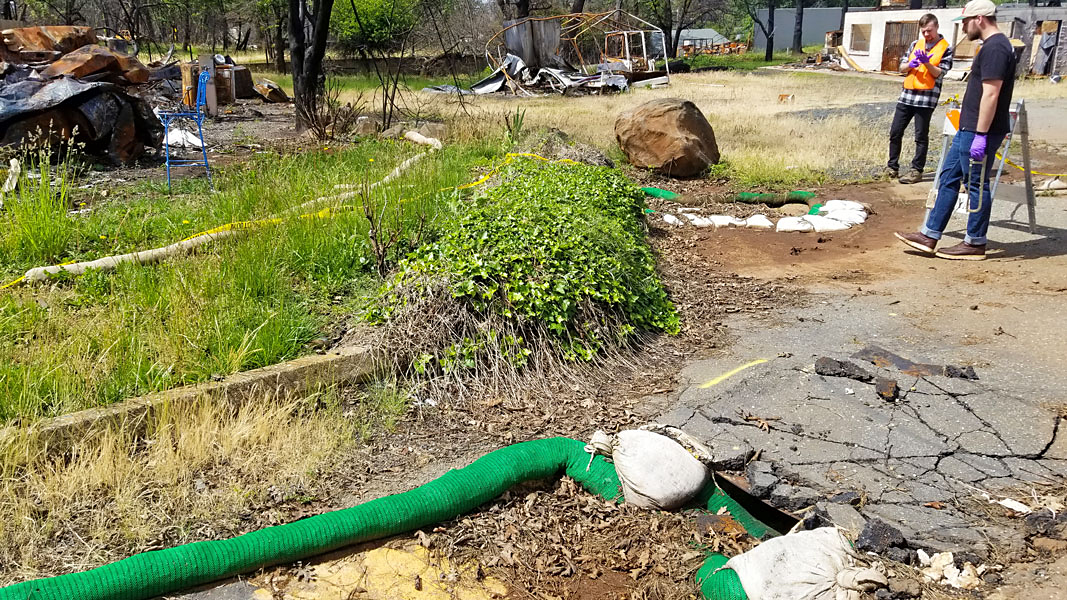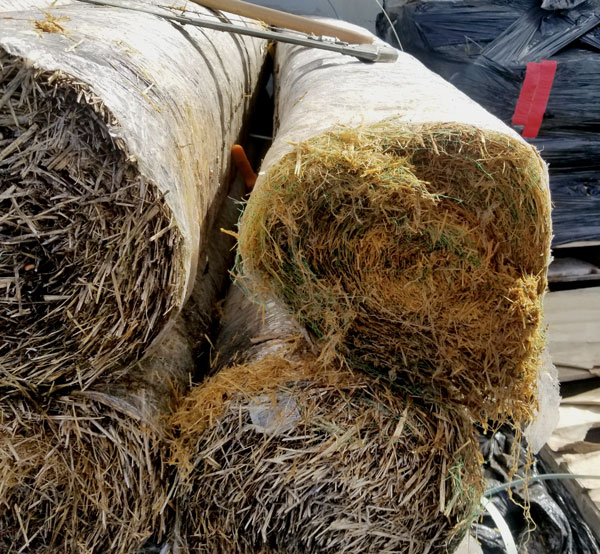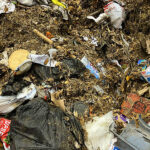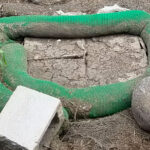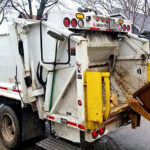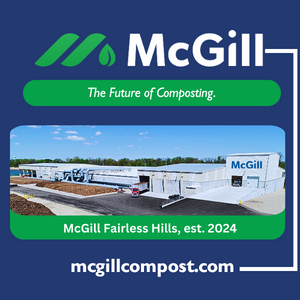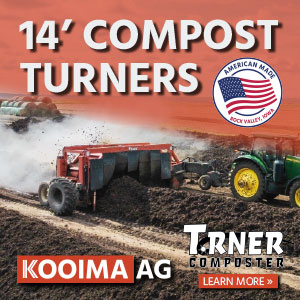Top: Compost filter socks (foreground, in green) and straw wattles (in background, in tan) were placed to control sediment/erosion in wildfire-ravaged California landscape. Photos courtesy Jackson Webster, California State University, Chico
Juliana Beecher
Compost filter socks are a tool for sediment retention and erosion control to mitigate impacts of stormwater runoff, especially runoff containing contaminants. They have been deployed in the cleanup and recovery efforts following some of California’s largest wildfires in recent years. This three-part series focuses on use of compost filter socks and other compost products in disaster recovery, starting with the Camp Fire in 2018 and subsequent research by California State University, Chico (Chico State), University of Nevada Reno, and CalRecycle. Part II examines use of compost-based products following the Los Angeles fires in 2025, and Part III looks at the decision-making involved in choosing (or not) to use compost-based products in disaster recovery.
Camp Fire Response
The Camp Fire started in early November 2018 and grew into the most destructive in California’s history, burning over 153,000 acres and almost 19,000 structures in Butte County in northern California. The town of Paradise and the community of Concow were almost completely destroyed, and other communities were heavily damaged. The Camp Fire was a wildland-urban interface (WUI) fire — one that burns in an area with houses and other structures in or near natural areas like forests or grasslands. Compared to fires that burn in undeveloped areas, WUI fires result in a greater variety of waste materials and potential for contaminants to be released as residential, commercial, and industrial buildings and vehicles burn. When it rains, fire-damaged land is prone to runoff due to vegetation loss and bare soil. Contaminants present in waste materials can be transported by stormwater runoff into local waterways, groundwater and, potentially, drinking water sources.
This was a concern with the Camp Fire, which burned right at the end of California’s dry season. Knowing that the rainy season was around the corner, deploying products to stabilize soil and retain sediment and toxins from “hot spots” — burned areas with higher concentrations of contaminants like household chemicals and electronics — was urgent.
Phase 1 of wildfire debris removal and recovery operations involved the immediate removal of visible household hazardous waste. For the Camp Fire, this was conducted by U.S. EPA Region 9. CalRecycle (the California Department of Resources Recycling and Recovery), a branch of the California Environmental Protection Agency that oversees the state’s waste management, recycling, and waste reduction programs, was assigned to direct Phase 2 of the cleanup. Phase 2 includes site assessments, asbestos assessments, soil testing, erosion control, and removal of remaining debris, contaminated ash and soil, and hazardous trees. Even before CalRecycle’s deployment, Butte County officials and the California Governor’s Office of Emergency Services (Cal OES) collaborated on erosion control measures.
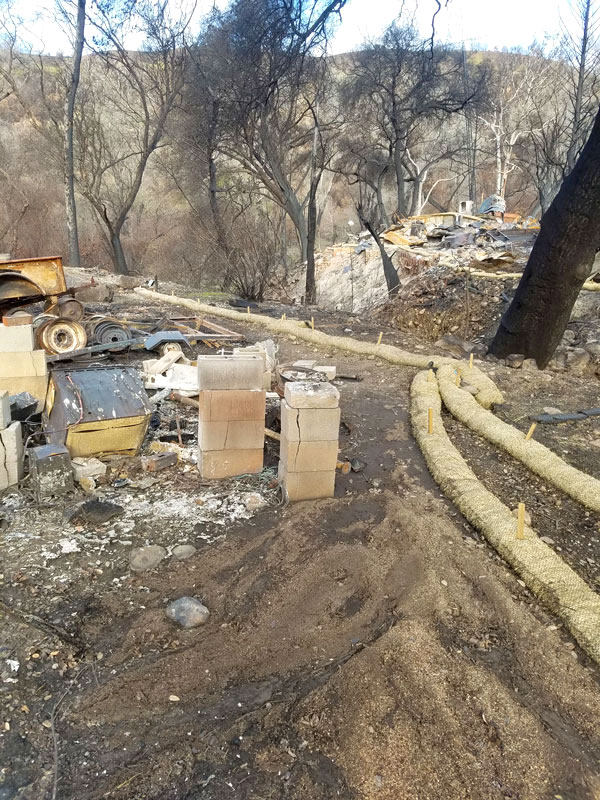
Straw wattles require trenching when installing, as well as staking to hold them in place. CFS also require staking.
During Phase 2, crews deployed compost filter socks (CFS) and straw wattles as erosion control measures around Paradise and other burned areas. CFS are tubes of mesh (synthetic, natural fiber or biodegradable material) filled with a coarse, woody compost. Straw wattles are thicker tubes of mesh filled with straw. Placed on soil surfaces, straw wattles require trenching, and both CFS and straw wattles require staking. However, on hard surfaces, CFS do not require staking as they stay in place once they get wet and heavy, especially with the help of sandbags. Both products were commonly used in wildfire cleanup at the time of the Camp Fire, although straw wattles were often preferred due to lower costs associated with materials. CFS and straw wattles were placed in areas requiring soil stabilization or sediment retention, like bare slopes. CFS were also placed on hardscapes (pavement, concrete, etc.) surrounding or downhill of hot spots — across the bottoms of paved driveways, around burnt parked vehicles, and at the entrance to storm drains — to capture and filter contaminants and sediment. Roughly one million lineal feet of CFS and over two million linear feet of straw wattles were used following the Camp Fire.
Compost Filter Sock Origins
CFS were added to the U.S. Environmental Protection Agency’s list of stormwater BMPs (best management practices) in 2005. Filtrexx invented compost filter socks and is the primary manufacturer in the U.S. Research led by Dr. Britt Faucette, formerly of Filtrexx, and other experts has shown the efficacy of CFS for sediment control and nutrient and pollutant removal in comparison to other erosion control products commonly used for post-construction and land disturbance applications, such as silt fences. CFS and compost filter berms are also deployed in highway construction projects. State transportation departments, including California’s, have issued specifications for CFS.
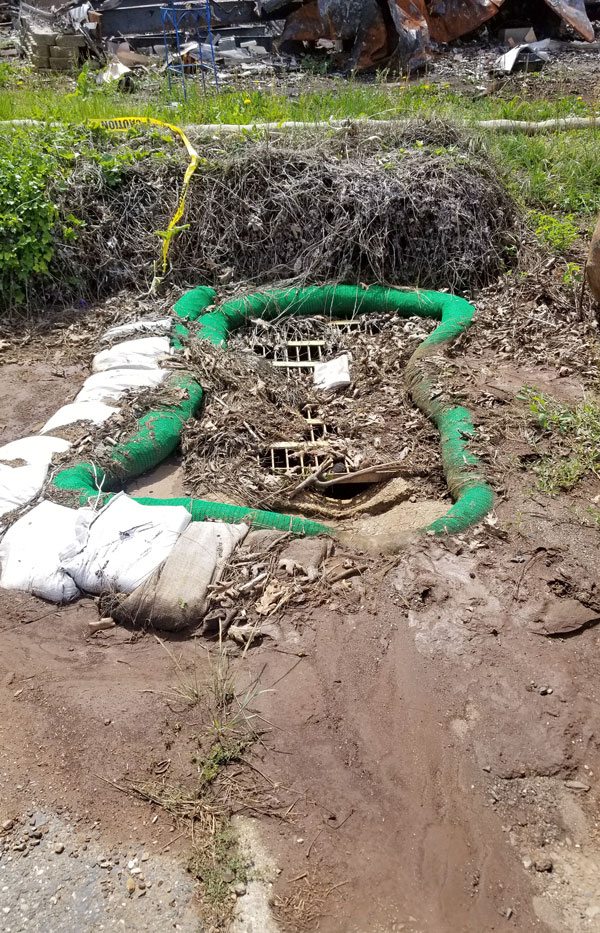
Compost filter socks installed around a storm drain to capture sediment and contaminants in the stormwater.
Filtrexx contracts with compost manufacturers to produce CFS in 5-inch or 8-inch diameters. Rapidly manufacturing CFS at the scale procured by CalRecycle and partners for the Camp Fire was no small feat. CFS manufacturing requires specialized equipment such as blower trucks with an attachment for the mesh “sock,” plus compost that meets the right size specifications — three-eighth- to two-inch particle size. Filtrexx happened to have mobile CFS manufacturing operations on the ground in northern California, due to involvement with response efforts for other fires in the 2018 season. CFS equipment and supplies were close enough to Paradise to meet Camp Fire cleanup needs.
Comparative Study Of CFS And Straw Wattles
Jackson Webster, a Professor of Civil Engineering at Chico State, was interested in the effects of the WUI Camp Fire on stormwater quality. With a team of students, he set up a plan to sample stormwater from around the watershed, searching for known contaminants associated with wildfires.
The CFS and straw wattles stayed in place through the rainy season, into the spring of 2019, as wildfire recovery continued. That spring, Webster decided it would be wise to collect samples of CFS and straw wattle contents (compost and straw, respectively), to see whether they corroborated what his team was finding for contaminants in local creeks. Chunks of the materials were cut out, and adjacent sediment and ash were scooped up and placed in bags that were then frozen. It was a “study of opportunity,” notes Webster. The materials were available, so they collected samples while they could, before the products were removed as recovery and rebuilding continued.
Robert Horowitz, manager of the organics unit at CalRecycle at the time, had been working for several years to promote the use of CFS in CalRecycle-led wildfire cleanups. He met Webster at an erosion control event held in Paradise in the spring of 2019. Horowitz immediately agreed to seek CalRecycle funding for Jackson’s research, specifically to compare the performance of CFS and straw wattles. The samples sat in freezers until 2022, when CalRecycle funding became available and Webster’s team began analysis.
The study — a collaboration between Chico State and the University of Nevada, Reno, and supported by CalRecycle — compared performance of straw wattles and CFS in retaining stormwater contaminants. A final report sharing findings was released in November 2024. While the erosion control benefits of both products were well-established, the ability of each to filter contaminants in stormwater specific to urban environments was less well-studied. Webster and team analyzed 22 samples of CFS, straw wattle and sediment for trace metals (As, Co, Cr, Cu, Ni, Pb, Zn), PFAS (39 cogeners), and polychlorinated dibenzo-p-dioxins and furans (PCDD/F or “dioxins and furans”). They also analyzed two samples from controls: straw wattles and CFS that were on the ground in Paradise throughout the rainy season, but not receiving stormwater runoff.
Findings (Table 1) show that “compost filter socks retained more contaminants than straw wattles,” states the study report. Notably, there was a statistical difference between the two products for six of the seven measured metals (all but chromium (Cr)). CFS also retained more PFAS cogeners (similarly structured compounds) and higher concentrations of PFAS than straw wattles. CFS had some detectable concentrations of PCDD/F, while straw wattles had none. Finally, notes the report, “deployment and management of products are important to ensure [best management practices (BMPs)] are effective for the use of either erosion control and/or contaminant retention.” During collection, the team noticed that some products were not deployed correctly, lacking stakes on soil slopes or not placed optimally to intercept stormwater and protect waterways.
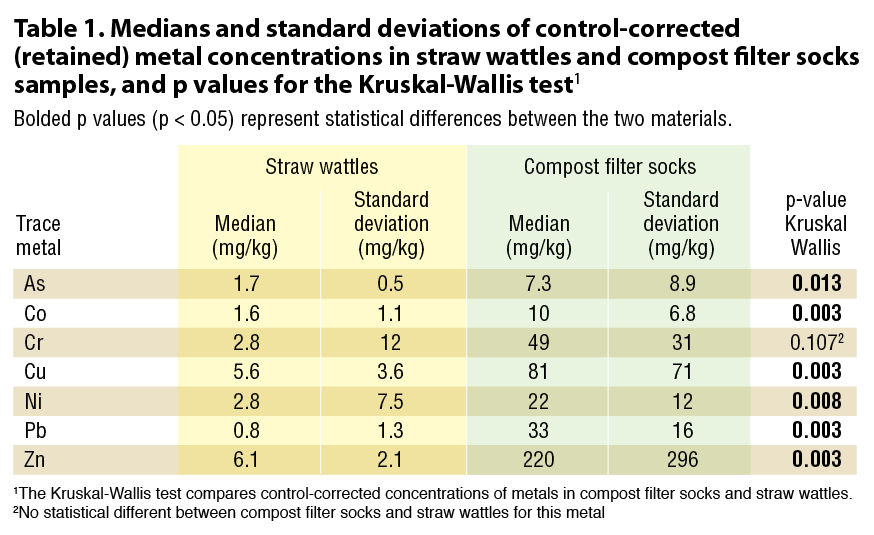 According to the study, CFS had “contaminant profiles that closely resembled those profiles found in adjacent sediment,” indicating that contaminants were effectively retained in the CFS rather than traveling with stormwater into local waterways and groundwater. Straw wattles did not show the same uptake of contaminants. In addition to particle capture, the “surface reactivity” of compost compared to straw explains the effectiveness of CFS. For example, tests showed increased PFOA sorption in CFS but almost zero sorption in straw wattles. Most chemical contaminants that are transported in stormwater are associated with organic compounds in particulates, and CFS are effective at filtering those out. To the study authors’ knowledge, this was the first time that PFAS and PCDD/F — stormwater contaminants common in urban environments — were measured post-wildfire or “urban burning.” The results showed that these contaminants are present following WUI fires and should be considered in cleanup efforts. Specifically, where there are “hot spots” that are likely to introduce toxic chemicals into runoff, or places where storm drains surrounded by burned debris are located on paved areas, compost socks offer a higher level of protection.
According to the study, CFS had “contaminant profiles that closely resembled those profiles found in adjacent sediment,” indicating that contaminants were effectively retained in the CFS rather than traveling with stormwater into local waterways and groundwater. Straw wattles did not show the same uptake of contaminants. In addition to particle capture, the “surface reactivity” of compost compared to straw explains the effectiveness of CFS. For example, tests showed increased PFOA sorption in CFS but almost zero sorption in straw wattles. Most chemical contaminants that are transported in stormwater are associated with organic compounds in particulates, and CFS are effective at filtering those out. To the study authors’ knowledge, this was the first time that PFAS and PCDD/F — stormwater contaminants common in urban environments — were measured post-wildfire or “urban burning.” The results showed that these contaminants are present following WUI fires and should be considered in cleanup efforts. Specifically, where there are “hot spots” that are likely to introduce toxic chemicals into runoff, or places where storm drains surrounded by burned debris are located on paved areas, compost socks offer a higher level of protection.
Webster notes that they might have done things differently with more planning or foresight, but this research provided valuable information for CalRecycle about what products to prioritize in fire cleanup. For Webster, future research might look more comprehensively at what exactly is in stormwater post-wildfires, especially in the “first flush” of contaminants during the first rain following a fire. “You only see what you’re looking for, and I’m always wondering, ‘what else is there?’,” Webster says. “After these fires, what’s making its way into stormwater?” Non-targeted analysis could identify contaminants floating around beyond those commonly measured. He adds that there’s more to learn about what size particles are still making their way through CFS, and how considerations of pore space and compost granularity could improve CFS technology and BMPs.
The community of Paradise was welcoming to the team’s research, Webster notes: “They care, they want to know what’s going into their water; they want to know what’s in their soil.” But that’s not guaranteed. Doing research in areas recently impacted by disasters is sensitive work. People are reeling from lost lives, property, and community. When talking about collecting samples of ash, “you’re really talking about the remnants of someone’s house,” he says. Being aware of permissions and having local connections helps, and “who you’re representing makes a difference too.” Webster has been chasing fires for 15 years, and now writes proposals for what he’ll study when the inevitable next fire happens and there’s funding to support research.
CalRecycle is also interested in future research on how compost-based products can both aid in wildfire recovery and in mitigation. For instance, can composted mulches create less combustible landscapes, especially around structures? Since the Camp Fire, CalRecycle has revised specifications for contractors, requiring use of compost erosion control materials, including compost filter socks where appropriate. The next article in this series will look at the use of compost-based products following the Los Angeles fires.
Juliana Beecher, a Contributing Editor to BioCycle, is a former ORISE Research Fellow with the U.S. EPA’s Office of Resource Conservation and Recovery. She works as a consultant based in Portland, Maine, focusing on bringing the food waste perspective to broader food systems conversations and efforts to build a more resilient food supply chain. Juliana extends her thanks to Robert Horowitz, Horowitz Engineering; Jackson Webster, California State University, Chico; Craig Kolodge, San Pasqual Valley Soils; and Angel Zhang and others at CalRecycle, for their assistance with this article series.


